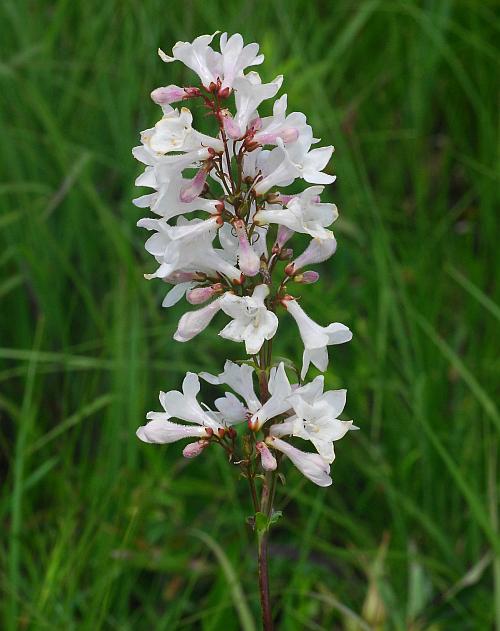Penstemon tubaeflorus Nutt.
Trumpet Beard-Tongue

Native
CC = 6
CW = 5
MOC = 41
© SRTurner
Penstemon tubaeflorus Nutt.Trumpet Beard-Tongue | |
 |
Native CC = 6 CW = 5 MOC = 41 |
© SRTurner |
|
Family - Plantaginaceae Habit - Perennial forb, from thick caudex. Stems - Strongly ascending to erect, to 1 m, glabrous (occasionally with 2 longitudinal lines of minute, glandular hairs extending partway to the stem base elsewhere), green or rarely slightly purplish-tinged, not glaucous.
Leaves - Basal and opposite. Basal leaves 2-11 cm long, the blade obovate to spatulate, rounded to bluntly pointed at the tip, tapered basally to a winged petiole, the margins entire or occasionally with sparse, minute, teeth, the surfaces glabrous, not glaucous. Stem leaves 1.5-14.0 cm long, reduced and relatively few toward the stem tip, variously lanceolate to oblong-lanceolate or narrowly ovate, bluntly to more commonly sharply pointed at the tip, sessile and mostly somewhat clasping, variously angled to rounded or cordate, the margins entire or with sparse, minute teeth, the surfaces glabrous, not glaucous.
Inflorescences - Narrow panicles, the central axis glabrous or sparsely glandular-hairy near the nodes, green to dark green or rarely somewhat purplish-tinged, not glaucous, with 4-8 nodes (dense and with the upper nodes not clearly separable in robust plants), each with a pair of relatively small, linear to lanceolate, somewhat clasping bracts, the branches strongly ascending, with a pair of branched clusters per node, each with 3-10 or more flowers. Pedicels to 1 cm long, pubescent with glandular hairs.
Flowers - Calyces 2.5-5.0 mm long at flowering, moderately to densely glandular-hairy, not glaucous, the lobes broadly lanceolate to ovate. Corollas 15-25 mm long, the tube slender, expanded evenly only toward the tip, nearly actinomorphic, the lobes spreading, the 3 lower lobes usually projecting slightly farther forward than the upper 2, white or the tube sometimes pale purplish-tinged toward the base, the throat lacking colored nectar guides and ridges, minutely glandular-hairy externally and in the throat. Stamens 4, adnate to lower half of corolla tube. Filaments to 1.5 cm long, white, glabrous. Anthers blackish, 1.7 mm long. Staminode white, slightly flattened toward the tip, curled-under apically and relatively sparsely bearded with yellow or brown hairs. Style 1 cm long, glabrous, white. Ovary glabrous, green, 3 mm long, 2 mm in diameter, 2-locular.
Fruits - Capsules 7-10 mm long. Seeds 1.0-1.5 mm long, tan to dark brown or black, the tan to reddish brown ridges usually poorly developed. Flowering - May - June. Habitat - Prairies, glades, savannas, forest openings, pastures, railroads, and roadsides. Origin - Native to the U.S. Lookalikes - P. digitalis, P. pallidus, P. arkansanus. Other info. - This showy penstemon occurs in Missouri primarily in the southwestern quadrant of the state, with a few scattered populations found elsewhere. Its global range is centered on Missouri's southwest corner and is predominantly contained within Missouri and the three other states surrounding that corner. At a glance, the species resembles the common P. digitalis, but the two are different in several ways. The most evident difference is the shape of the corolla, which is nearly actinomorphic rather than being strongly bilabiate. The corolla tube also expands smoothly outward from the base, rather than having a more abrupt swelling. The throat of the corolla is glandular as well. The inflorescence is usually dense and distinctly cylindrical, and the stem below it typically appears almost naked. Photographs taken at the Kansas City Zoo, 6-27-00, and at Prairie State Park, Barton County, MO., 6-23-00 (DETenaglia); also at Drury-Mincy Conservation Area, Taney County, MO, 5-2-2012, Diamond Grove Prairie Conservation Area, Newton County, MO, 5-18-2016, and Tingler Prairie Natural Area, Howell County, MO, 6-10-2021 (SRTurner). |